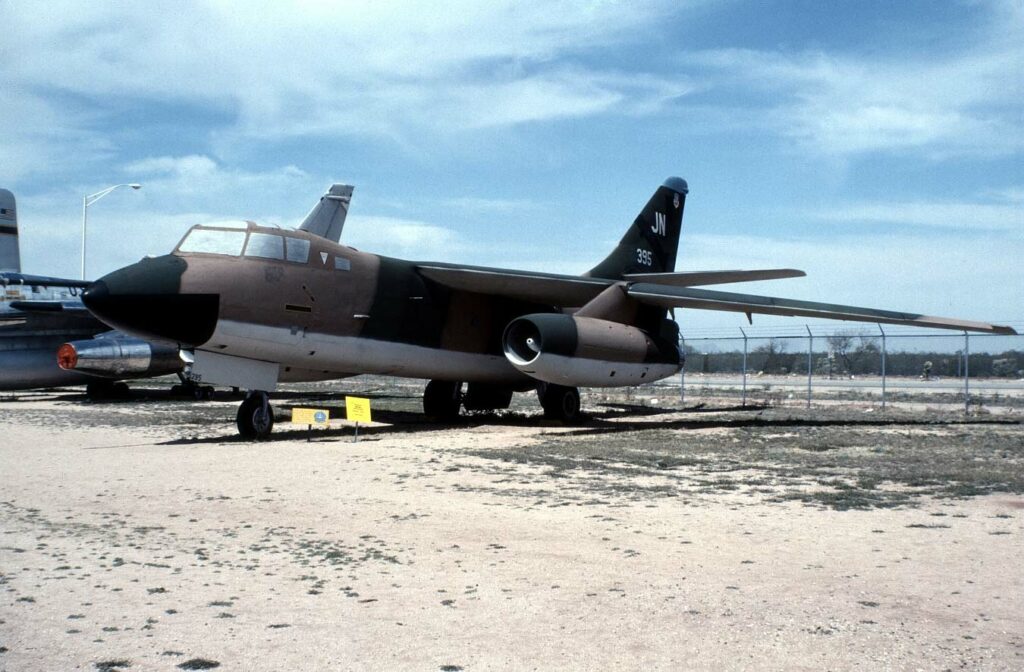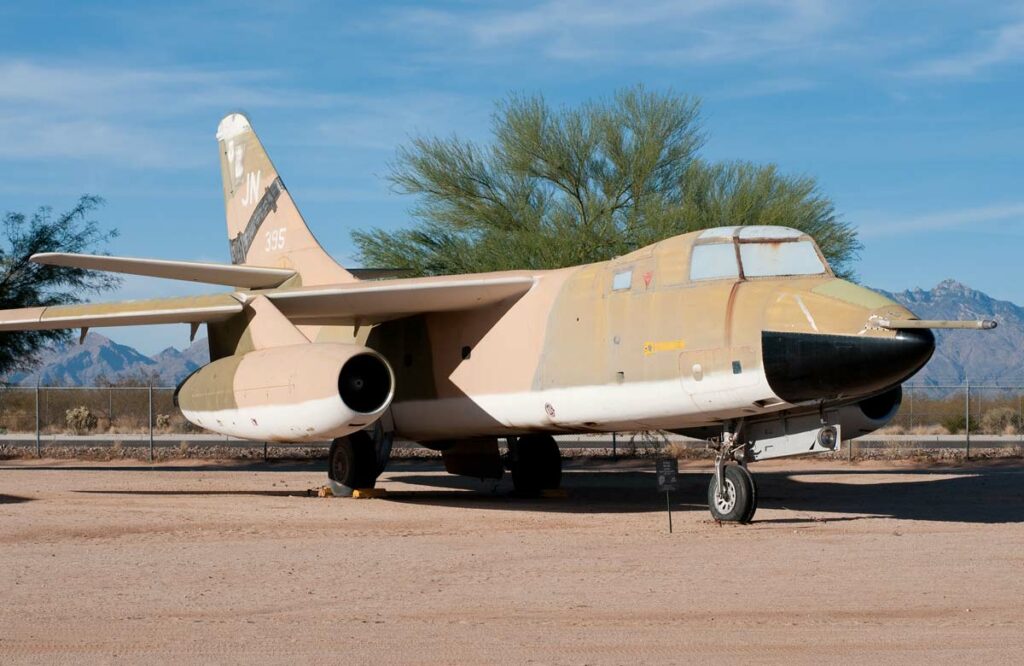The Douglas B-66 Destroyer is a twin-engine, light bomber and reconnaissance aircraft, developed for the United States Air Force in the 1950s.
in Brief
The Douglas B-66 Destroyer, introduced in 1956, was developed by Douglas Aircraft Company as a land-based light bomber and reconnaissance aircraft for the United States Air Force. Derived from the carrier-based A-3 Skywarrior, it featured two Allison J71 turbojet engines, each producing 10,200 lbs of thrust. With a length of 22.9 meters, a wingspan of 22.1 meters, and a height of 7.2 meters, the B-66 had a maximum takeoff weight of 38,000 kg and could carry up to 7,000 kg of payload. It reached a maximum speed of 634 mph, a cruise speed of 410 mph, and a service ceiling of 39,370 feet. Equipped with a remote-operated, radar-guided tail turret with two 20mm cannons, the B-66 could carry up to 15,000 lbs of ordnance in its internal bomb bay.
The Douglas B-66 Destroyer played a vital role as a multi-role aircraft in the Cold War era, performing reconnaissance, electronic countermeasures, and light bombing missions. Despite its designation as a bomber, it gained a reputation for its versatility in non-bombing roles.

History of the Development of the Douglas B-66
In response to the United States Air Force’s demand for a replacement for the aging Douglas A-26 Invader, a contract was secured with Douglas Aviation Company to develop a strictly land-based light bomber version of the United States Navy’s A-3 Skywarrior. The project aimed to adapt the naval Skywarrior for Air Force requirements while maintaining its essential design features. The B-66 Destroyer was the result of this effort.
The development of the B-66 Destroyer began in the early 1950s, with the first aircraft conducting its maiden flight on June 28, 1954. Despite its basis on the A-3 Skywarrior, the B-66 required significant redesign and adaptation, including a complete overhaul of the power systems, repositioning hydraulic pumps and generators onto the engines themselves. The crew compartment was pressurized and given a different structure with a glazed front position for the pilot. The landing gear was also redesigned with a different door geometry, and ejection seats were added—a feature lacking in the A-3.
The B-66 faced numerous development challenges, including the substantial redesign work. However, the test program with the pre-production aircraft led to improvements in the production models. The first production B-66B, with increased gross weight and other refinements, flew on January 4, 1955. Deliveries began in 1956, but the USAF decided to curtail the bomber variant’s procurement, canceling further orders and relegating the model to various test programs. The RB-66B, the principal production model, incorporated the bomber version’s upgrades and was produced or retrofitted into a variety of other versions.
Design of the Douglas B-66
The Douglas B-66 Destroyer’s design was influenced by its naval predecessor, the A-3 Skywarrior. It featured a slab-sided fuselage with an exterior length of 22.9 meters, a height of 3.7 meters, and a fuselage diameter of 2 meters. The aircraft had a high-mounted swept wing with a wingspan of 22.1 meters and a wing area of 72 square meters. The tail had a sizable vertical tail fin with a tail height of 7.19 meters and conventional horizontal stabilizers. The B-66 was equipped with a fully retractable landing gear with a wheelbase of 8.5 meters.
Powered by two Allison J71-A-11 single-spool turbojet engines, the B-66 was an afterburning turbojet with a 16-stage axial compressor, cannular combustors with ten flame tubes, 3-stage turbine, and pressure spray oil system. Each engine produced a maximum thrust of 10,200 lbf. The aircraft had a maximum speed of 548 knots at 6,000 feet and a cruise speed of 459 knots. The combat range was 782 nautical miles, while the ferry range was 2,146 nautical miles. It could fly up to 39,400 feet and could climb at a rate of 5,000 feet per minute.
The aircraft had a maximum takeoff and landing weight of 37,650 kg and 25,455 kg, respectively. It had a maximum payload of 7000 kg and a fuel capacity of 4,650 gallons. The B-66’s design incorporated a monoplane arrangement with a high-mounted, swept-back mainplane. The mainplane design utilized a single primary wing mainplane, representing the most popular modern mainplane arrangement.
Performance of the Douglas B-66
The Douglas B-66 Destroyer’s performance was notable for its time. The aircraft’s twin Allison J71 turbojet engines allowed it to reach a maximum speed of 634 mph, a cruise speed of 410 mph, and a service ceiling of 39,370 feet. The B-66’s range was 2,467 miles, with a rate of climb of 5,000 feet per minute.
When compared to other aircraft of its era, the B-66 was a capable and versatile platform. Its speed and altitude capabilities made it suitable for a variety of roles, including reconnaissance, electronic warfare, and light bombing missions. While it was not as heavily armed or armored as some dedicated bombers of the time, its agility and electronic warfare capabilities gave it an edge in certain operational scenarios.
Variants of the Douglas B-66
The Douglas B-66 Destroyer was produced in several variants, each tailored to specific mission requirements. The B-66 “Destroyer” was the base series designation. The RB-66A was the pre-production photographic reconnaissance variant, with five examples produced. The RB-66B was the definitive photographic reconnaissance mark, fitted with Allison J71-A-13 engines, with 149 examples produced. The EB-66E was a highly specialized Electronic CounterMeasure (ECM) model based on the RB-66B. The B-66B was the tactical light bomber variant based on the RB-66B, with 72 examples produced. Additionally, the RB-66C was a specialized electronic reconnaissance and ECM aircraft.

Military Use and Combat of the Douglas B-66
Over its service life, the B-66/RB-66 took on sorties involving the Cuban Missile Crisis and the Vietnam War. Most of its career centered on the reconnaissance role, where valuable data on enemy positions was essential to upcoming offensives and air strikes. ECM versions also supplied the necessary jamming of North Vietnam air defense radar systems, coupled to deadly ground-based fire and Surface-to-Air Missile (SAM) emplacements.
In service, the RB-66 functioned as the primary night photo-reconnaissance aircraft of the USAF during this period. Many examples served with tactical reconnaissance squadrons based overseas, typically being stationed in the United Kingdom and West Germany. A total of 72 of the B-66B bomber version were built, fewer than had been originally planned. A total of 13 B-66B aircraft were later modified into EB-66B electronic countermeasures (ECM) aircraft, playing a forward role in the Cold War between the United States and the Soviet Union.
These aircraft, along with the RB-66Cs that the 42nd received, saw combat service during the Vietnam War. Unlike the US Navy’s A-3 Skywarrior, which performed bombing missions in the theater, the Destroyer did not perform bombing missions in Vietnam. The RB-66C was the first aircraft designed from the onset for electronic intelligence (ELINT) missions. It was operated by an expanded crew of seven, which included additional electronics warfare specialists. Several RB-66Cs were operated in the vicinity of Cuba during the Cuban Missile Crisis. They were also deployed over Vietnam. During 1966, these planes were re-designated as EB-66C.
Unarmed EB-66B, EB-66C, and EB-66E aircraft flew numerous missions during the Vietnam War. They helped gather electronic intelligence about North Vietnamese defenses and provided protection for bombing missions of the Republic F-105 Thunderchiefs by jamming North Vietnamese radar systems.
The Douglas B-66 Destroyer stands as a significant aircraft in Cold War military history, known for its versatility and effectiveness in reconnaissance and electronic warfare roles. Despite its designation as a bomber, it never dropped a bomb in combat but instead carved out a niche as an intelligence-gathering and electronic warfare platform. Its contributions in conflicts such as the Vietnam War and during the Cuban Missile Crisis illustrate its strategic value. The B-66’s legacy is marked by its adaptability, technological advancements, and the crucial role it played in the United States Air Force’s operations during a pivotal era of military aviation.
Back to the Bombers section.